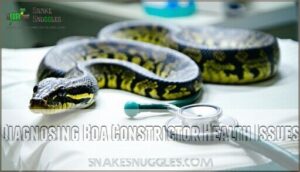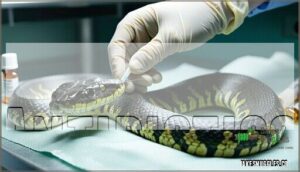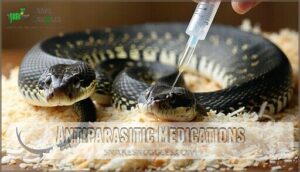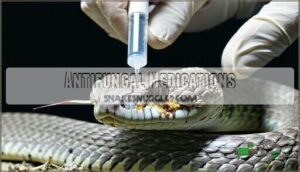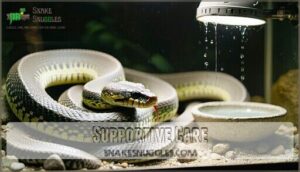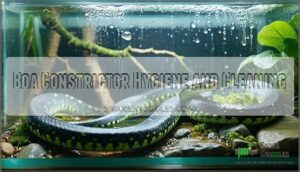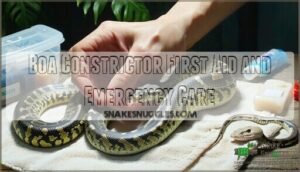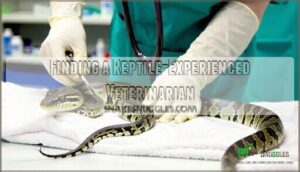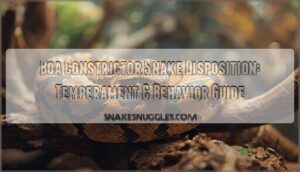This site is supported by our readers. We may earn a commission, at no cost to you, if you purchase through links.
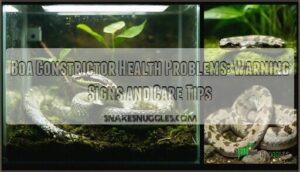
Respiratory infections are common, often caused by low temperatures or humidity. Watch for wheezing or mucus around the nose.
Parasites, both internal and external, can sneak in, so keep an eye on stool quality and shedding. Inclusion Body Disease (IBD) is serious, causing neurological issues and appetite loss—definitely one for the vet.
Stomatitis (mouth rot) shows up as swollen gums or pus in the mouth. Changes in behavior, appetite, or shedding are red flags too. Stay sharp, and a clean, warm environment can save a lot of headaches!
Table Of Contents
- Key Takeaways
- Common Boa Constrictor Health Issues
- Signs of Illness in Boa Constrictors
- Diagnosing Boa Constrictor Health Issues
- Treating Boa Constrictor Health Problems
- Preventing Boa Constrictor Health Issues
- Boa Constrictor Hygiene and Cleaning
- Boa Constrictor First Aid and Emergency Care
- Boa Constrictor Nutrition and Feeding Issues
- Finding a Reptile-Experienced Veterinarian
- Boa Constrictor Enclosure and Habitat Tips
- Frequently Asked Questions (FAQs)
- What illness do boa constrictors have?
- How to tell if a boa is dehydrated?
- Are boa constrictors high maintenance?
- Are boa constrictors prone to diseases?
- Do boas have health problems?
- Are boa constrictors healthy?
- Can a boa constrictor cause a respiratory infection?
- What illnesses do boa constrictors get?
- What disease do common boas get?
- What are the first signs of IBD in boas?
- Conclusion
Key Takeaways
- You’ll need to watch for respiratory infections, which often show up as wheezing, nasal discharge, or open-mouth breathing—these typically stem from poor ventilation or incorrect humidity levels in your boa’s enclosure.
- Keep an eye on your snake’s eating habits, bathroom patterns, and shedding cycles since sudden changes in appetite, stool consistency, or incomplete sheds can signal underlying health problems that need veterinary attention.
- You can prevent most health issues by maintaining proper temperature gradients (85-90°F warm side, 75-80°F cool side), humidity levels at 60-70%, and keeping the enclosure clean to avoid bacterial infections and parasites.
- Don’t skip regular vet checkups with a reptile-experienced veterinarian—early detection through fecal exams and routine health assessments can catch problems like parasites or Inclusion Body Disease before they become serious.
Common Boa Constrictor Health Issues
Your boa constrictor’s health is essential for its happiness and longevity.
But these snakes can face some common health problems, from respiratory infections to parasites.
Knowing what to watch for helps you address issues early and keep your pet thriving.
Respiratory Infections
Respiratory infections are common boa constrictor health problems, often caused by poor ventilation or improper humidity.
Symptoms like wheezing, nasal discharge, and open-mouth breathing signal trouble. Catch these snake health issues early to avoid complications.
Here’s what to watch for:
- Symptoms: Whistling sounds, bubbles from the nose, labored breathing.
- Causes: Incorrect habitat settings.
- Treatment: Veterinarian-prescribed antibiotics.
Prevention? Maintain proper ventilation and humidity levels in your boa’s enclosure.
Skin Problems
Your boa’s skin is its health scoreboard.
Watch for warning signs like discolored scales, incomplete or retained sheds, or raised patches that may hint at trouble.
Boa constrictor scale rot often shows as reddish spots, while rostral abrasion stems from rubbing on rough surfaces.
For stuck sheds, a warm bath works wonders.
Prevent common reptile skin diseases like fungal lesions by ensuring proper humidity and spotting mite infestations during regular checkups to avoid skin diseases.
Parasites
How can you spot trouble with boa constrictor parasites? Look for signs like mites or ticks scuttling over scales or unusual weight loss, often caused by internal worms or protozoal infections.
Regular health checks and quick action can stop parasites in their tracks.
- Common issues: mite infestations, tick troubles, internal worms.
- Parasitic infection signs: unusual droppings.
- Prevention: consistent hygiene.
- Tools: fecal exams with a vet.
- Control: quarantine new snakes carefully.
Inclusion Body Disease (IBD)
Inclusion Body Disease (IBD) is a dangerous viral condition impacting boa constrictor health.
It’s known for neurological problems like unsteady movements, “stargazing,” and trouble flipping upright.
Here’s a quick overview:
| IBD Aspect | Details |
|---|---|
| Symptoms | Stargazing, regurgitation, loss of coordination |
| Transmission | Contact with infected snakes or poor hygiene |
| Diagnosis | Vet exams, visible inclusion bodies in cells |
| Prevention | Strict quarantine, clean environments |
If you spot symptoms, see a reptile vet promptly.
Stomatitis (Mouth Rot)
Mouth rot, or stomatitis, is a painful reptile bacterial infection that can seriously affect boa constrictor health if ignored.
Causes of stomatitis include poor enclosure hygiene, stress, and untreated injuries.
Watch for these boa illness symptoms:
- Red, swollen gums that scream discomfort
- Thick, smelly discharge in the mouth
- Refusing food, even favorite prey
Treatment options involve cleaning the infected area, antibiotics prescribed by a reptile vet, and boosting enclosure cleanliness and humidity.
Preventing stomatitis means routine tank maintenance and quick care for cuts.
Post-treatment care keeps your boa constrictor strong and stress-free.
Signs of Illness in Boa Constrictors
Spotting illness in your boa constrictor early can make all the difference in keeping them healthy.
Early detection of illness is the key to a healthier, happier boa constrictor and peace of mind for you.
Watch for subtle changes in behavior, appetite, or appearance, as these often signal something’s wrong.
Changes in Appetite
When your boa suddenly skips meals (sudden anorexia) or seems hungrier than ever (increased appetite), it’s worth investigating.
Food refusal, regurgitation causes, or unusual weight fluctuations can point to boa constrictor health problems like stress, parasites, or improper temperatures.
Watch for sluggish behavior or poor digestion alongside these appetite shifts.
A healthy boa constrictor diet includes steady feeding habits, so if patterns change, don’t ignore it—small issues can quickly grow into bigger boa constrictor health concerns, related to improper temperatures or parasites.
Changes in Stool or Urine
Keep a close eye on your boa’s bathroom habits—it’s like reading their health diary!
Monitor urate changes, stool consistency, color abnormalities, and frequency shifts.
Runny or oddly colored stools might hint at digestive issues or snake regurgitation causes, while decreased output could signal dehydration or even boa constrictor constipation.
Volume changes or signs of boa constrictor prolapse shouldn’t be ignored.
Spot something unusual? Seeking boa constrictor vet care guarantees small health problems don’t balloon into major concerns.
Discharge or Redness in The Eyes
If your boa constrictor shows red, swollen, or discharge-filled eyes, it could indicate an eye infection, mite infestation, or retained eyecap.
These boa constrictor health problems might seem minor but can escalate.
Bulging eyes or a raw, irritated snout (rostral abrasion) also signal trouble.
Check their eyes daily.
Clear, bright eyes mean good health, but if issues arise, don’t delay—seek reptile veterinary care immediately.
Changes in Skin or Shedding Patterns
Changes in your boa constrictor’s skin or shedding patterns can hint at health issues.
Watch for these problems:
- Retained shed: Patchy, dull skin left after incomplete shedding.
- Scale discoloration or abnormal textures: Signs of snake skin diseases or bacterial dermatitis.
- Skin lesions or bumps: Possible snake fungal infection or other skin diseases.
- Frequent shedding problems: Indications of dehydration or stress.
A healthy boa should shed in one piece.
If shedding struggles persist, reevaluate care and consult a vet.
Unusual Behavior
Noticing your boa’s behavior shift can feel like spotting a storm on the horizon—worth attention.
Watch for lethargy signs, erratic movements, or hiding excessively.
Regurgitation causes concern too, especially paired with weight loss or basking avoidance.
Behavioral changes like sudden aggression or skipping meals shouldn’t be ignored.
Trust your instincts; you know its patterns best.
Unusual boa constrictor behavior often signals health issues, so consult a reptile vet swiftly for peace of mind.
Diagnosing Boa Constrictor Health Issues
To keep your boa constrictor healthy, you’ll need to identify potential issues early.
Routine vet visits, fecal exams, and occasional blood tests or imaging can help uncover hidden problems before they become serious.
Veterinary Check-Ups
In the context of boa constrictor veterinary care, annual reptile health checkups are your secret weapon for keeping your snake in top shape.
These visits allow for early detection of potential health problems, saving you headaches later.
A reptile veterinarian will check weight, look for parasites, and certify overall wellness.
Preventative care is worth every penny, so communicate with your vet about costs and concerns.
Think of it as an investment in your boa’s long life!
Fecal Exams
Fecal exams are a must for spotting hidden issues like snake parasites.
They’re simple but essential steps in boa constrictor health care.
Follow these tips:
- Sample collection: Collect a fresh feces sample—no older than 24 hours.
- Exam frequency: Schedule lab analysis every 6-12 months for early parasite detection.
- Lab analysis: Vets will identify eggs, larvae, or adult parasites, helping diagnose boa constrictor health problems.
- Vet interpretation: Review detailed results with your vet to plan effective reptile parasite control.
Prevention beats unplanned emergencies!
Blood Tests
When addressing boa constrictor health problems, blood tests are invaluable for diagnosing reptile diseases and ensuring effective reptile health management.
By analyzing blood parameters, your vet can quickly spot infections, organ dysfunction, or nutritional gaps.
During sample collection, care is taken to minimize stress or anesthesia risks.
While the process sounds complex, these tests have immense diagnostic utility for interpreting symptoms and providing personalized veterinary care for reptiles.
It’s a small step to keep your boa thriving!
Imaging Studies
X-rays and ultrasound imaging are go-to tools in snake veterinary care, offering a sneak peek at boa constrictor health problems like bone damage, tumors, or organ issues.
For more complex reptile diseases, advanced options like CT scans or MRI benefits provide ultra-detailed views.
Sometimes, vets use contrast agents to highlight hidden trouble spots.
These non-invasive methods let vets investigate reptile health without poking around, ensuring your scaly friend gets the care it needs quickly and safely.
Treating Boa Constrictor Health Problems
Treating your boa constrictor’s health issues starts with understanding the right tools and care methods, like antibiotics or antiparasitic treatments.
Acting quickly and consulting a qualified reptile vet can make all the difference in ensuring your snake recovers fully, which is a key aspect of using treatments effectively.
Antibiotics
Snake bacterial infections often need antibiotics, but only a reptile vet can guide you on antibiotic types or dosage calculation.
These treatments may involve injections, oral meds, or topical applications. Always finish the course to dodge resistance issues.
Watch for side effects and pair antibiotics with probiotics support to help recovery. Your boa’s health problems deserve attentive snake veterinary care and proper treatment administration!
It’s also important to watch for signs of Stomatitis, which may require antibiotic therapy.
Antiparasitic Medications
Parasites, like mites or internal burdens such as nematodes and cestodes, can wreak havoc on your boa.
Thankfully, antiparasitic medications, such as Ivermectin for surface mites or Praziquantel for endoparasites, offer targeted solutions.
These medications neutralize parasitic infections without harming your snake—if used correctly, with dosage calculation being key; too much risks serious side effects, while too little may lead to resistance issues.
Stick closely to your vet’s guidance and avoid preventative use unless advised, as proper care is essential to prevent parasites from thriving in neglect.
Keep precaution a priority for a thriving boa!
Antifungal Medications
Fungal infections in boa constrictors require swift action, often involving azole or polyene antifungals. Addressing snake fungal infections promptly prevents complications.
Your vet might recommend topical treatments or systemic antifungals based on the severity of fungal lesions.
Here’s what to expect during treatment:
- You’ll apply prescribed medications as directed—don’t skip doses to avoid resistance development.
- Clean the enclosure with Virkon or Chlorhexidine to limit reinfection and manage snake diseases.
- Monitor your boa’s progress closely; early improvements often signal effective reptile medicine.
Restoring healthy scales feels incredibly rewarding!
Supportive Care
Supportive care is like rolling out the red carpet for recovery in boa constrictor care. Focus on maintaining hydration methods, stress reduction, and a clean quarantine setup.
Create a cozy space with minimal handling and let your snake relax. A recovery habitat with easy-to-clean surfaces and hides works wonders.
| Care Tip | Example |
|---|---|
| Hydration Methods | Provide fresh, clean water daily |
| Temperature Range | 85°F-90°F (day basking), 75°F-80°F (night) |
| Stress Reduction | Offer multiple hides for privacy |
| Appetite Stimulants | Small, heated prey can encourage feeding |
| Wound Management | Clean abrasions with veterinary-approved antiseptic |
Preventing Boa Constrictor Health Issues
Keeping your boa constrictor healthy starts with providing a clean, spacious habitat and consistent care.
Regular vet visits, a proper diet, and quarantine for new additions can help prevent common health issues.
Proper Housing and Environment
Setting up your boa constrictor enclosure shouldn’t feel like rocket science, but you’ll need some basics.
Use a well-ventilated reptile habitat with a temperature gradient—85-90°F for the warm side, 75-80°F for the cool.
Maintain boa constrictor humidity at 60-70% with a hygrometer, and get accurate readings from a reptile humidity gauge, which are essential for maintaining proper humidity levels.
Substrate choice matters—try coconut fiber or cypress mulch, and toss in secure hides, and remember, cage cleaning is your secret weapon against bacteria and stress.
It’s that simple!
Balanced Diet and Nutrition
A balanced boa constrictor diet is essential to prevent nutritional deficiencies and health complications like obesity or fatty liver disease.
Keep your snake healthy with these tips:
- Prey Variety: Rotate prey types to guarantee balanced reptile nutrition.
- Supplementation Needs: Gut-load live prey with nutrients and add vitamin D3 for calcium absorption.
- Obesity Prevention: Feed appropriately sized prey no larger than 1.5 times your boa’s widest point.
- Hydration Importance: Always provide fresh water to aid digestion and overall health.
Proper nutrition keeps your boa thriving and happy!
Regular Veterinary Check-Ups
Regular veterinary check-ups aren’t just for furry pets—they’re your boa constrictor’s ticket to long-term health.
Visit a reptile veterinarian twice a year for early detection of issues and proper preventative care.
| Check-Up Detail | Explanation | Importance |
|---|---|---|
| Parasite Screening | Identifies internal or external pests | Prevents serious health issues |
| Husbandry Review | Evaluates enclosure conditions | Guarantees optimum living environment |
| Boa Constrictor Health | Overall physical evaluation | Monitors general wellbeing |
| Veterinary Care | Personalized medical advice | Guides health management plans |
Think of it as tuning up a prized classic car—routine boa constrictor care today prevents breakdowns tomorrow, ensuring your pet’s general wellbeing and optimum living environment with proper veterinary care and preventative care.
Quarantine Procedures
Introducing a new boa constrictor? Keep your current collection protected with proper reptile quarantine procedures. Isolation setups are critical to catch reptile health problems early.
Keep new arrivals separate for 30-60 days and take no chances. Monitor your boa daily for signs like parasites or respiratory issues.
- Use separate handling tools to avoid cross-contamination.
- Disinfect feeding equipment thoroughly after use.
- Consider preventative treatments during quarantine duration.
- Maintain record keeping to track behaviors or health changes.
Boa Constrictor Hygiene and Cleaning
Keeping your boa constrictor’s enclosure clean isn’t just about looks—it’s essential for their health.
By regularly disinfecting surfaces and washing your hands before handling, you can prevent infections and keep your snake thriving.
Cleaning The Enclosure
A clean boa constrictor enclosure is like a fresh start for your snake’s health.
First, move your boa to a secure temporary setup.
Spot clean daily to handle waste removal and maintain enclosure hygiene.
Replace substrate choices monthly and deep clean every two weeks with reptile-safe disinfecting methods.
For a variety of options, consider using a reptile enclosure cleaner.
Verify everything, including decorations and hard-to-reach corners, is dry before reassembling.
| Cleaning Task | Frequency | Tools Needed |
|---|---|---|
| Spot Cleaning | Daily | Paper towels, gloves |
| Substrate Replacement | Monthly | Fresh substrate, trash bags |
| Deep Cleaning | Every Two Weeks | Reptile disinfectant, scrubber |
Keep the schedule—you’ll thank yourself later!
Disinfecting Food and Water Dishes
Keeping a boa healthy means spotless dishes!
Use hot, soapy water daily to scrub away grime and biofilm. Once a week, sanitize with safe disinfectants, like diluted bleach (1:10).
Pick sturdy, smooth-surface materials for easier washing. Clean dishes preserve water quality, prevent reptile disease, and maintain high-quality hygiene.
Smart reptile care equals fewer boa constrictor health problems!
Washing Hands Before Handling
Handwashing is a small task with big benefits for your boa and your family.
It helps reduce bacteria and prevent transmission of zoonotic diseases.
Practice these reptile hygiene practices every time:
- Wash hands with antibacterial soap for at least 20 seconds.
- Use hand sanitizers when soap isn’t handy.
- Avoid handling after using lotions or oils.
- Clean under fingernails to remove debris.
- Dry hands completely to avoid passing moisture to your boa.
Hygiene is key to reptile care and preventive care for reptiles.
Boa Constrictor First Aid and Emergency Care
When emergencies happen, knowing how to respond quickly can make a big difference for your boa constrictor’s health.
From minor injuries to more serious issues, having basic first-aid knowledge helps you handle unexpected situations with confidence.
Wound Care
When your boa sustains an abrasion, act fast to promote healing and prevent infection.
Start by cleaning wounds with diluted betadine to gently remove debris—skip alcohol or hydrogen peroxide; they damage tissue.
Minor cuts respond well to topical treatments like Neosporin or Polysporin, but keep an eye out for redness or swelling, which signal infection.
For deep wounds or persistent issues, seek veterinary intervention. Consider specialized products for boas to aid in the healing process.
Keep the enclosure spotless during recovery, as cleanliness helps stave off skin infections. Think of recovery time as spa days for your scaly friend!
Treating Respiratory Issues
Respiratory infections in boas can sneak up fast, so act as soon as you spot wheezing, bubbles, or mouth breathing.
Maintain a tidy, humid environment and keep temperatures cozy at 85-90°F. Cleanliness and ventilation are your snake’s best allies. One potential cause is improper humidity levels that can lead to bacterial pneumonia.
Here’s how to aid recovery:
- Humidity control: Use misting or humidifiers.
- Antibiotic options: Consult a reptile vet for treatment.
- Nebulization therapy: Ask about medicated mist treatments.
- Preventing recurrence: Regular check-ups and ideal care.
Don’t wait—snake respiratory infections can escalate.
Dealing With Escape or Injury
When handling escape or injury, stay calm.
For escapes, check warm spots—think water heaters or under appliances. If injured, clean wounds using diluted betadine and consult your vet.
| Issue | Cause | Action | Tools Needed |
|---|---|---|---|
| Escape | Enclosure security flaw | Inspect for gaps, seal errors | Tools for repairs |
| Minor Wound | Sharp enclosure objects | Clean with betadine | Betadine, sterile gauze |
| Serious Injury | Handling mishap | Contact vet immediately | Vet info, transport crate |
| Post-Escape Stress | Disruption | Monitor behavior, rehydrate | Fresh water, quiet space |
Inspect the boa constrictor enclosure regularly to prevent escapes.
Boa Constrictor Nutrition and Feeding Issues
Feeding a boa constrictor isn’t just about dropping in a rodent and calling it a day; their diet and feeding schedule play a vital role in their health.
Understanding proper portions, frequency, and common feeding mistakes can help you avoid serious issues like malnutrition or obesity.
Malnutrition
Visible backbone, sunken sides, or loose skin folds might indicate dietary deficiencies like vitamin imbalances.
Malnutrition from an inadequate boa constrictor diet, such as limited prey variety, can even lead to organ failure.
To tackle reptile vitamin deficiency, dust prey with calcium or vitamins and diversify meals.
Regular supplementation needs might prevent other boa constrictor health problems, boosting overall health and well-being.
Overfeeding
Overfeeding can quickly lead to boa constrictor health problems, like obesity and digestion troubles.
It’s tempting to feed generously, but too much food can harm your snake’s growth rate and overall health. Stick to feeding charts and match prey size to your boa’s midsection to prevent issues.
Excess feeding causes:
- Obesity risks, stressing organs like the liver and heart.
- Regurgitation due to slowed digestion or oversized prey.
- Fat buildup leading to snake digestive issues.
To keep your boa healthy, focus on proper portions and adjust feeding frequency as they grow. Remember, it’s about balanced nutrition, not indulgence!
Feeding Frequency and Schedule
Feeding your boa constrictor the right way keeps it healthy and active.
Start with age-based schedules to guarantee their diet matches their needs. Baby boas eat every 5-7 days; juveniles thrive on meals every 7-10 days.
Subadults and adults can handle less frequent feeding—every 10-14 or 14-21 days, depending on size. Always offer prey matching the thickest part of their body.
Avoid overfeeding to prevent boa constrictor obesity. Watch for regurgitation causes like oversized prey or frequent feeding. Seasonal adjustments may further fine-tune their schedule.
Finding a Reptile-Experienced Veterinarian
Finding a veterinarian who understands reptiles isn’t always easy, but it’s vital for your boa’s health.
You’ll want to check credentials, ask for referrals, and verify they’ve experience with exotic pets.
Researching Local Veterinarians
Start your search for reptile vets by checking online directories for those with exotic experience and board certifications in reptile medicine.
Look for reviews to gauge their reputation and compare costs.
Make certain the clinic offers emergency availability—you never know when boa constrictor health problems might arise.
A qualified vet guarantees better boa constrictor medical care, from check-ups to handling serious reptile health services.
Asking for Referrals
When looking for a reptile vet, referrals are your best friend! Ask fellow boa owners, breeders, or local pet shops for trusted recommendations. Many boa constrictor care enthusiasts are part of robust communities, eager to share their experiences.
Remember that regular check-ups are essential for preventative care.
Here’s where to start:
- Client testimonials from reptile owners.
- Engage in online forums or social media groups.
- Tap into breeder networks.
- Investigate vet partnerships for specialized snake health expertise.
Checking Credentials and Experience
When evaluating a reptile vet, expertise verification and qualification assessment are key.
Check for board certifications and training focused on reptile medicine, especially boa constrictor care.
Experience matters—ask how long they’ve treated snake health issues.
A reputable vet should confidently discuss boa constrictor health problems backed by scientific knowledge.
Your snake deserves the best, so don’t hesitate to ask direct questions—your curiosity fuels their credibility!
Boa Constrictor Enclosure and Habitat Tips
Providing your boa constrictor with a well-designed habitat guarantees its health and happiness. Focus on secure enclosures, proper temperatures, and the right humidity to create a safe, comfortable space.
Creating a Secure Enclosure
A secure boa constrictor enclosure is your snake’s safe haven. Think of it as a fortress with escape prevention in mind—secure locks are a must!
Glass enclosures work great for visibility and controlling the environment. Choose a substrate like coconut fiber or cypress mulch, which maintains humidity while being easy to clean.
Add hiding spots to help your boa feel safe; a stressed snake isn’t a healthy one. A thoughtfully designed boa constrictor habitat guarantees both safety and comfort in your reptile care routine.
For adequate space, remember to review adult boa enclosure sizes.
Maintaining Proper Temperature Gradients
Keeping your boa healthy means mastering temperature regulation in its enclosure. Boa constrictors rely on proper temperature gradients for thermoregulation, mimicking nature’s warm-cool cycles. Without this balance, they might develop serious health problems.
Here’s how to do it right:
- Create a warm basking spot around 88-90°F and a cooler side at 78-80°F for proper gradient monitoring.
- Use reliable heat sources, like ceramic heaters or basking bulbs, while avoiding heating rocks.
- Add thermostats for precise temperature gradient control, and double-check with thermometers at both ends.
- Keep night temperatures slightly lower, ensuring your boa rests comfortably.
When the setup’s spot-on, you’ll help your boa thrive—happy, healthy, and headache-free!
Humidity and Lighting Levels
A healthy boa constrictor thrives with balanced humidity and proper lighting.
Keep humidity at 60-70% using humidity sources like misting or moisture-retaining substrates. A hygrometer is your best friend for accurate levels, helping with shedding success and infection prevention.
For lighting, provide a day-night cycle using full-spectrum bulbs, ensuring natural thermoregulation impact. Though boas don’t require UVB, it supports subtle health benefits.
Good lighting types and steady temperature gradients make their enclosure a perfect haven!
Providing Hides and Climbing Structures
A well-thought-out boa constrictor enclosure setup doesn’t just look good—it meets your snake’s environmental needs while promoting reptile wellbeing.
Including hides and climbing structures helps with stress management and encourages natural behavior.
- Provide variety: Use cork bark, hollow logs, or reptile hides crafted for snakes.
- Ensure climbing safety: Add sturdy branches or platforms with secure structural integrity.
- Go naturalistic: Artificial plants and décor mimic their natural environment.
- Rotate options: Switch out hides periodically to keep things fresh.
Enrichment benefits your snake’s health by reducing boredom and supporting physical activity, ensuring a happy, thriving boa constrictor!
Frequently Asked Questions (FAQs)
What illness do boa constrictors have?
An ounce of prevention is worth a pound of cure.
Boa constrictors face respiratory infections, parasites, scale rot, and mouth rot.
Watch for wheezing, swollen scales, or appetite loss.
Proper care and vet checks are key.
How to tell if a boa is dehydrated?
You can spot dehydration in your boa by looking for wrinkled or sunken skin, sticky saliva, and sunken eyes.
If its poop is unusually dry or it refuses water, it’s time to rehydrate!
Are boa constrictors high maintenance?
Boa constrictors aren’t super high-maintenance, but they do need consistent care.
You’ll manage proper temperatures, humidity, and regular feedings.
Once their setup’s right, they’re pretty low effort compared to dogs or cats.
Are boa constrictors prone to diseases?
About 30% of boas can experience health issues like respiratory infections, parasites, or mouth rot.
With proper care, you’ll avoid most problems.
They’re hardy reptiles but, like anyone, need a clean, well-managed environment to thrive.
Do boas have health problems?
Your boa can face health issues like respiratory infections, parasites, or scale rot if care slips.
Keeping precise humidity, temperatures, and cleanliness helps prevent problems.
Monitor behavior closely—your snake’s habits often reveal early warning signs.
Are boa constrictors healthy?
They’re generally hardy and low-maintenance if you meet their care needs.
However, just like any pet, they can face health issues like respiratory infections or parasites.
Regular checkups and proper husbandry keep them thriving.
Can a boa constrictor cause a respiratory infection?
Yes, they can.
Respiratory infections usually come from improper temperatures or humidity.
If your snake wheezes, breathes through its mouth, or shows nasal discharge, it’s time to check enclosure conditions and consult a reptile vet.
What illnesses do boa constrictors get?
Your boa constrictor could face issues like respiratory infections, mouth rot, scale rot, mites, or internal parasites.
Keep an eye out for symptoms like wheezing, swollen gums, or lethargy, and consult a reptile vet when needed, as these can be signs of serious health issues such as respiratory infections.
What disease do common boas get?
Your boa constrictor can encounter issues like respiratory infections, parasites, mouth rot, or scale rot.
Keep temperatures, humidity, and cleanliness in check. It’s like snake preventative care, ensuring their home’s squeaky clean and comfy!
What are the first signs of IBD in boas?
Unfortunately, your snake won’t send you a formal resignation letter before IBD strikes.
You’ll first notice neurological symptoms like head tilting, corkscrewing movements, and regurgitation episodes that seem oddly persistent and worrying.
Conclusion
Keeping your boa healthy isn’t rocket science, but it does require attention to detail.
By monitoring for common boa constrictor health problems like respiratory infections, parasites, and skin issues, you’ll catch problems early when they’re easier to treat.
Remember that prevention beats treatment every time—maintain proper temperatures, humidity levels, and cleanliness in your snake’s enclosure.
Regular vet checkups and prompt action when you notice warning signs will keep your boa thriving for years to come, which is the ultimate goal of proper care.







